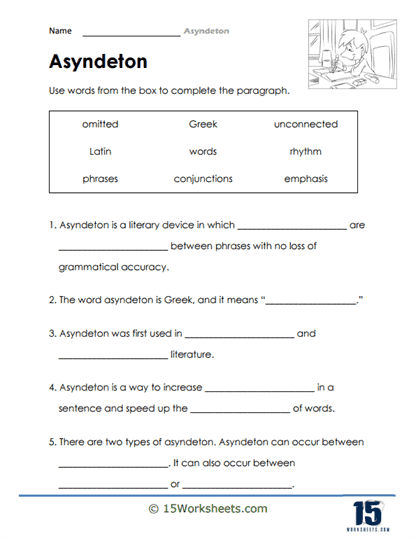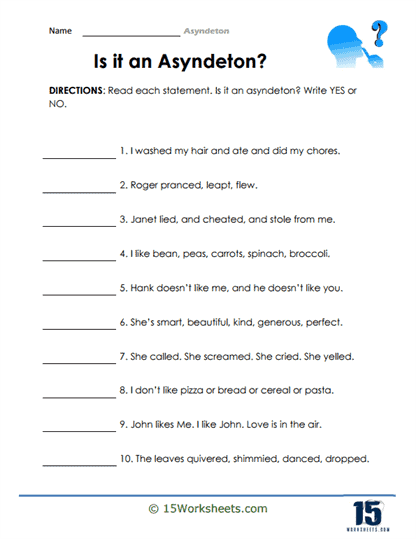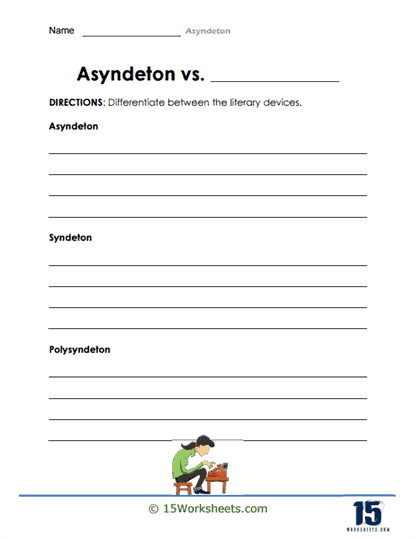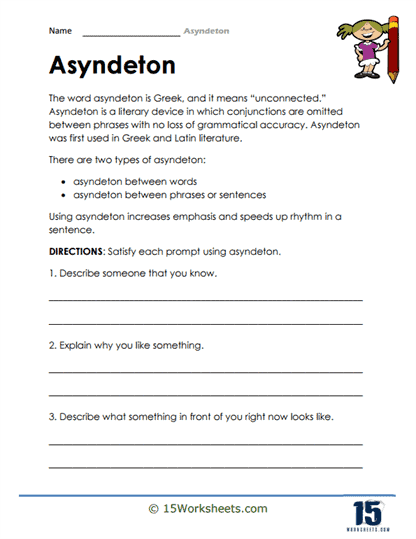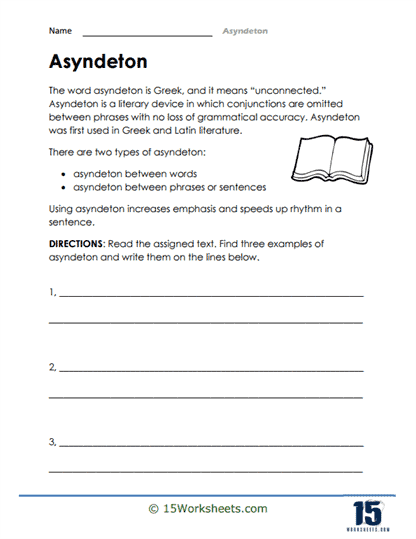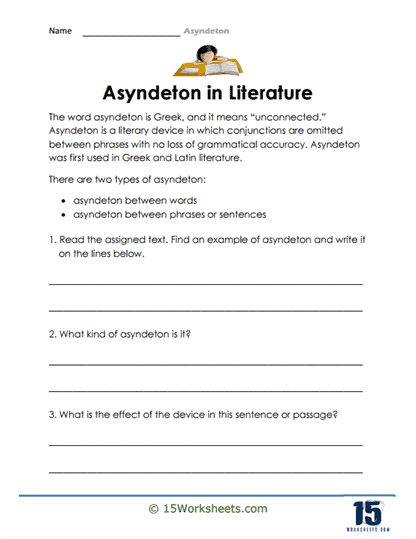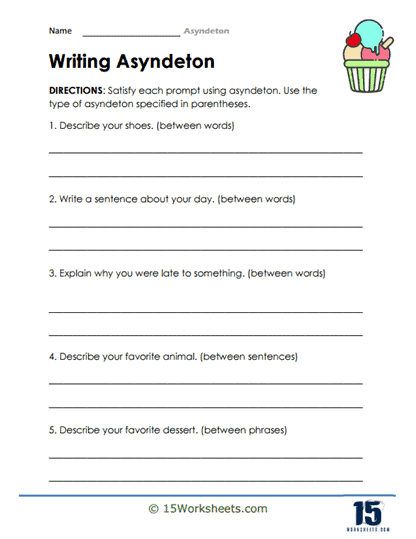Asyndeton Worksheets
All About These 15 Worksheets
Asyndeton, the deliberate omission of conjunctions (such as “and,” “but,” or “or”) from a series of related clauses or phrases, is a powerful and nuanced rhetorical device. Understanding and mastering asyndeton not only deepens a student’s appreciation for language and rhetoric but also enhances their writing and communication skills.
In a world where effective communication, clarity, and persuasion are essential, students must develop the ability to recognize, employ, and appreciate the art of asyndeton in their writing and speech. To empower students with the knowledge of asyndeton and its multifaceted applications, we proudly present a collection of 15 worksheets on Asyndeton. These worksheets are meticulously designed to provide students with structured and engaging opportunities to explore, practice, and master the use of asyndeton.
How Do These Asyndeton Worksheets Help Students?
These worksheets are like your own personal training fields where you get to practice being a superhero, like Asyndeton. These worksheets are filled with sentences that need your help. They might have too many ‘ands’, ‘ors’, or ‘buts’, and it’s your job to make them better.
These worksheets may have different types of exercises. Some might have sentences filled with conjunctions and you would need to rewrite them using Asyndeton. An example could be – “She likes apples, and oranges, and bananas, and grapes.” You would rewrite it as – “She likes apples, oranges, bananas, grapes.”
Some worksheets may ask you to identify Asyndeton in a given passage. Remember, you’re looking for sentences where ‘and’, ‘or’, ‘but’, etc. are not used to separate items in a list.
Other worksheets may have a fun exercise where you get to write your own story using Asyndeton. Maybe you could write about a day in the life of your favorite superhero or what you did during your summer vacation. The point is to practice using Asyndeton to make your sentences more exciting.
Working with Asyndeton worksheets can be an adventurous journey. You learn to add more drama and speed to your sentences, making your stories more captivating. Remember, it’s all about practice. The more you work with these worksheets, the better you will get at using Asyndeton. You can start seeing it in books, stories, even in speeches by famous people.
Here are a few examples of what an asyndeton worksheet include:
Definitions and Examples – The worksheet may provide a definition of asyndeton and offer several examples from literature or famous speeches. Students can read and analyze these examples to understand how asyndeton is used and its impact on the overall meaning and tone.
Identify the Asyndeton – The worksheet may present sentences or passages where asyndeton is used. Students are then asked to identify and underline the instances of asyndeton within the text. This exercise helps them recognize and isolate asyndeton in actual writing.
Fill in the Blanks – The worksheet might provide sentences or passages with missing conjunctions, and students are required to fill in the appropriate asyndeton. This activity encourages students to actively apply their knowledge of asyndeton by reconstructing sentences without the conjunctions.
Analyzing the Effect – In this exercise, the worksheet may provide students with sentences or short passages that contain asyndeton. Students are then asked to explain the effect of the asyndeton on the reader or listener. This exercise helps students understand the impact of asyndeton on tone, pacing, and emphasis in writing.
Writing Practice – The worksheet may include prompts or writing tasks that encourage students to incorporate asyndeton into their own compositions. This allows students to experiment with asyndeton and gain a deeper understanding of its effects on their own writing style.
Asyndeton worksheets are like a gym for your writing muscles. They help you get better at using Asyndeton, the technique that removes conjunctions from sentences to make them more exciting. Asyndeton worksheets are tools that train you to become a better and more engaging writer. They help you learn how to write sentences that are short, snappy, and punchy, capturing your reader’s attention and making your writing more enjoyable to read.
What Is The Effect Of Asyndeton On The Reader?
Asyndeton, a literary technique that involves intentionally leaving out conjunctions between words, phrases, or clauses, can have several effects on the reader. Let’s explore some of these effects:
Speeds Up the Pace – When conjunctions are omitted, the reader tends to move more quickly from one idea or image to the next. This accelerates the rhythm of the prose or poetry, creating a sense of urgency or intensity. For example, in the sentence, “I ran, I jumped, I climbed,” the actions seem more immediate and frantic without the use of ‘and’ between them.
Creates Emphasis – By eliminating conjunctions, each item in the list can stand on its own, thereby gaining more prominence. This can highlight each individual aspect more vividly, making them more memorable to the reader.
Adds Drama and Excitement – Asyndeton can make a sentence or passage more dramatic. By eliminating conjunctions, the narrative can seem more spontaneous, and this can heighten the emotional intensity of the text.
Conveys Overwhelming Emotions or Actions – Asyndeton can be used to create a sense of overwhelming emotion or action. For instance, in describing a scene of chaos, the author might choose to use asyndeton to reflect the overwhelming number of things happening simultaneously.
Imitates Real-Life Speech – In many casual or emotional conversations, we often omit conjunctions. By using asyndeton, writers can mirror this aspect of natural, spoken language, thus making their characters or narrators seem more real and relatable.
Highlights Relationships – When conjunctions are left out, it can force the reader to pay closer attention to the relationship between the listed items or ideas. This can lead to a deeper understanding or appreciation of the writer’s message.
The Importance of Understanding Asyndeton
Understanding asyndeton and its various forms is of great importance for several reasons:
- Effective Communication: Asyndeton can enhance the rhythm and flow of language, creating impact and emphasis in communication. Proficiency in employing asyndeton equips students with a powerful tool for conveying ideas persuasively.
- Clarity and Conciseness: Asyndeton promotes clarity and conciseness in writing by streamlining sentences and emphasizing key points. Students learn to communicate more efficiently and effectively.
- Rhetorical Awareness: Recognizing asyndeton in speeches, essays, and other forms of discourse helps students analyze the rhetorical strategies used by speakers and writers, deepening their critical thinking skills.
- Literary Appreciation: Asyndeton is a common device in literature. Understanding it allows students to appreciate the stylistic choices of authors and poets and engage with literary texts on a deeper level.
This collection of Asyndeton worksheets is a valuable resource for educators and parents committed to nurturing effective communication, critical thinking, and writing skills in students. Proficiency in recognizing, analyzing, and employing asyndeton equips individuals with the tools to craft compelling arguments, enhance writing style, and engage with the nuances of language in a meaningful way. This collection is an investment in their future success, ensuring they have the skills to communicate clearly and persuasively in an information-rich world where concise and impactful communication is invaluable.
Embrace these Asyndeton worksheets today, and watch your students become skilled communicators who can skillfully employ asyndeton to emphasize ideas, craft memorable sentences, and engage their audience effectively in the art of language and persuasion.









